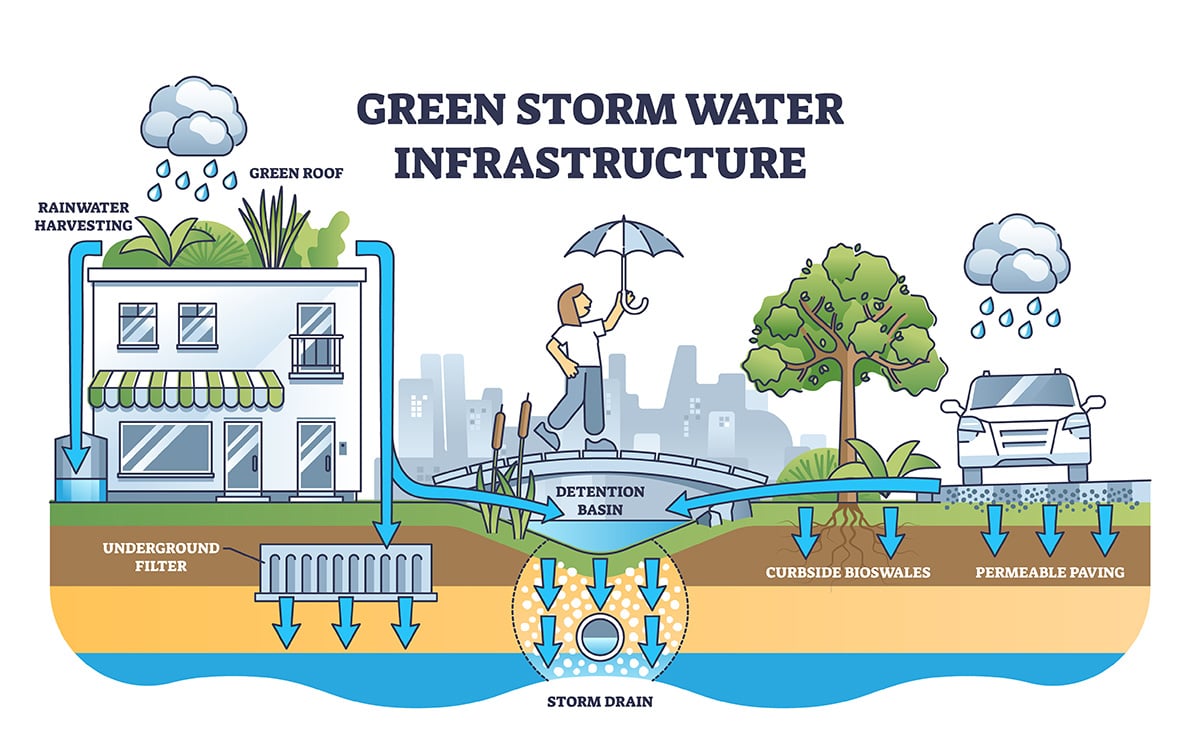Commit to Climate Resilient Land Management
Best Management Practices (BMPs) or Green Infrastructure

Best Management Practices (BMPs) or green infrastructure deals with the incorporation of stormwater management activities.
Implementation of BMPs has been through a partnership with the Clean Water Partnership Program (CWP).
Treating and Teaching (T&T) Program
“Consider the entire school grounds as a teaching opportunity, with a central space as the outdoor learning area or classroom.”
Training and motivating educators and facility managers to enable outdoor learning is at the core of the Treating and Teaching (T&T) Program.
Treating and Teaching has been implemented at 55 schools and has also included stormwater BMPs at a few offices, centers and community complexes.
Learn More About Storm Water BMP Types
“BMPs are classified and conceptualized as scale-based and type-based. The scale-based category classifies them according to the size of the application area, such as lot-, community-, or watershed-scales. The type-base category classifies them into three types according to the geometric properties:
- Point BMPs: Practices that capture upstream drainage at a specific location and may use a combination of detention, infiltration, evaporation, settling, and transformation to manage flow and remove pollutants.”
- Linear BMPs: Narrow linear shapes adjacent to stream channels that provide filtration of runoff, nutrient uptake, and ancillary benefits of stream shading, wildlife habitat, and aesthetic value.
- Area BMPs: Land-based management practices that affect impervious area, land cover, and pollutant input.”1
Point BMPs Implemented in T & T Program
What are Point BMPs?
Point BMPs “capture upstream drainage at a specific location and may use a combination of detention, infiltration, evaporation, settling, and transformation to manage flow and remove pollutants.”1
- Bioretention - 50
- Micro-Bioretention - 81
- Rainwater Harvesting - 1
- Oil Grit Separator - 3
- Submerged Gravel Wetlands - 11
- Infiltration Basin - 1
- Detention Structure Dry Pond - 1
- Extended Detention Structure - 2
- Sand Filter - 3
- Retention Pond (Wet Pond) - 1
Linear BMPs Implemented in T & T Program
What are Linear BMPs?
Linear BMPs “provide filtration of runoff, nutrient uptake, and ancillary benefits of stream shading, wildlife habitat, and aesthetic value.”1
- Grassed Swales - 3
- Infiltration Trenches - 11
- Bio-Swales - 4


Linear BMPs Types and Quantities in PGCPS
Area BMPs Implemented in T & T Program
What are Area BMPs?

Area BMPs are “Land-based management practices that affect impervious area, land cover, and pollutant input.”1
- Permeable Pavements - 11
- Green Roof - Intensive - 2
- Green Roof - Extensive - 1
- Flood Management Area - 3
- Rain Gardens - 3
- Landscape infiltration - 1
BMP Implementation in Our Schools
BMPs in Elementary Schools
BMPs in Middle Schools
BMPs in High Schools
1 Environmental Protection Agency, Best Management Practices (BMPs) Siting Tool | US EPA as published on April 14, 2023.
